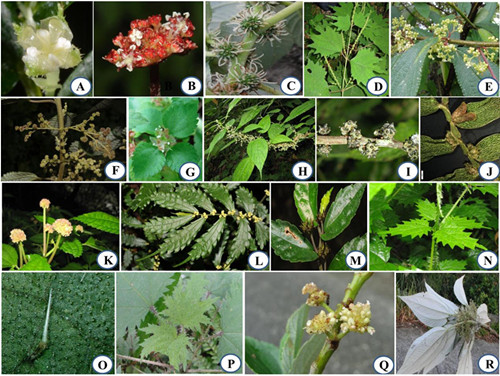The family Urticaceae consists of approximately 54 genera with more than 2000 species, and is widely distributed in tropical regions but less common in temperate regions, with by far the largest concentration of genera and species in tropical Asia. Historically, most of the diagnostic morphological characters used in classifications of Urticaceae are of such small size that microscopic work is always necessary to obtain accurate identifications of species. This, combined with high species diversity and the absence of a well-sampled phylogeny, has been challenging to previous efforts to elucidate relationships within Urticaceae.
To generate a phylogenetic hypothesis of generic and tribal relationships within Urticaceae, PhD student WU Zengyuan, supervised by Prof. LI Dezhu, from Kunming Institute of Botany, in collaboration with botanists of the Royal Botanic Gardens at Kew and Edinburgh, used the most comprehensive taxon sampling to date, encompassing 47 of the 54 recognized genera within Urticaceae, including four of the six sometimes separated as Cecropiaceae, and conducted phylogenetic analyses based on the DNA sequences of two nuclear loci, four chloroplast regions, and one mitochondrial gene, using three analytical methods (ML, MP, and BI). Major results included: (1) Urticaceae including Cecropiaceae was monophyletic; (2) Cecropiaceae was biphyletic, with both lineages nested within Urticaceae; (3) Urticaceae can be divided into four well-supported clades; (4) previously erected tribes or subfamilies were broadly supported, with some additions and alterations; (5) the monophyly of many genera was supported, whereas Boehmeria, Pellionia, Pouzolzia and Urera were clearly polyphyletic, while Urtica and Pilea each had a small genus nested within them; (6) relationships between genera were clarified, mostly with substantial support. These results clarify that some morphological characters have been overstated and others understated in previous classifications of the family, and provide a strong foundation for future studies on biogeography, character evolution, and circumscription of difficult genera.
This paper has been published online in Molecular Phylogenetics and Evolution (IF=4.066). http://authors.elsevier.com/sd/article/S1055790313002625
This work was supported by a Keynote Project of National Natural Science Foundation of China (Grants No. 40830209). Zeng-Yuan Wu was supported by the China Scholarship Council for one year study at the Natural History Museum, and the Royal Botanic Gardens, Kew.

Fig. 1 The conceptual phylogenetic tree produced by Bayesian Inference (BI) analysis based on seven loci from three genomes. Numbers associated with branches (ML_BS/MP_BS/BI_PP) are assessed by Maximum Likelihood Bootstrap (ML_BS), Maximum Parsimony Bootstrap (MP_BS) and Bayesian posterior (BI_PP).

Fig. 2 Morphological diversity of Urticaceae.




